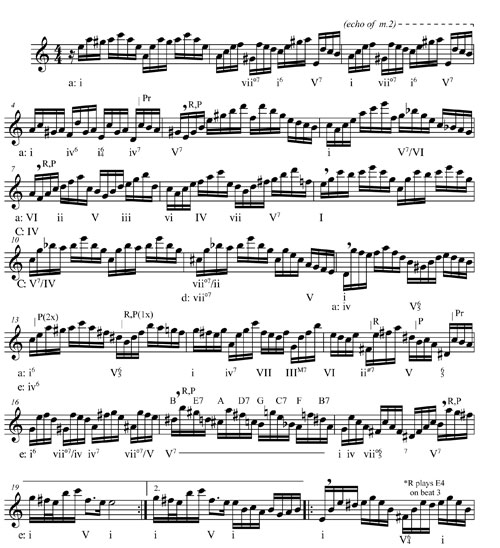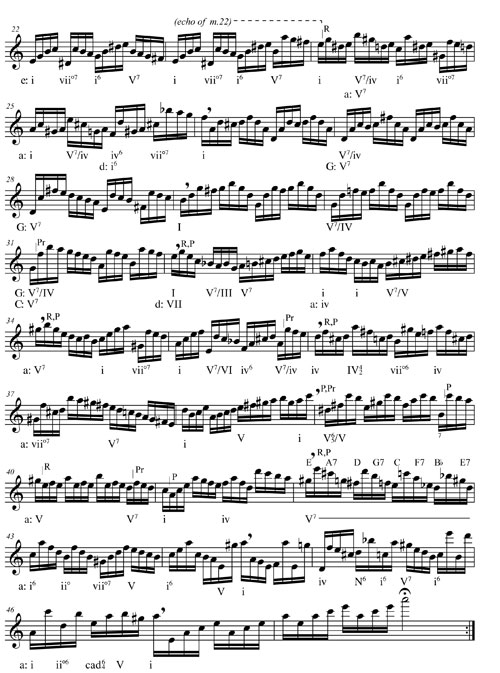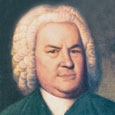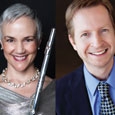The Baroque style of composing music for a solo instrument that consists of an unbroken stream of sixteenth notes, completely devoid of rests, poses a challenge for the performer. One must decide where to breathe and where to take phrase endings in the absence of rhythmic cues. While some spots are intuitively obvious, others leave ample room for interpretation. The following examines where three renowned flutists – Jean-Pierre Rampal, Emmanuel Pahud and Stephen Preston – choose to breathe and take time in their performances of the Allemande from Bach’s Partita for Solo Flute, BWV 1013, and how their choices relate to the work’s melodic and harmonic structure.
Recordings by all three flutists suggest that perhaps the four most important factors in deciding where to breathe are lung capacity, the return of material, both transposed and untransposed, cadential gestures, and the presence of melodic and harmonic sequences. The annotated score on the following pages provides a complete Roman numeral analysis with breath marks that indicate where all three performers took a breath. Breath marks that are followed by the initials R (Rampal), P (Pahud), or Pr (Preston) show where two performers took a breath, and vertical lines followed by the same initials indicate where only one took a breath.
Lung Capacity
Most would agree that making musical decisions based on purely physical limitations like lung capacity will result in a substandard performance. Nevertheless, one cannot ignore the fact that wind players must breathe, and to maintain a beautiful tone, circular breathing is not an option. Of the three artists, only Stephen Preston goes for more than four measures without a breath, and he only does this once. The average span measured from breath to breath on the three recordings is three or four measures. While it would be easy to take breaths more frequently, the absence of any rests encourages the artists to maintain a sense of perpetual motion, and all three recordings respect this aesthetic.
Melodic Returns
When melodic material serves as the beginning of a phrase early on, it demands a parallel treatment when it returns later. All three performers consequently took breaths immediately before the return of the material from m. 1 when it returned in mm. 9, 21, 26 and 29. There are other melodic returns that did not elicit the same response, such as the return of m. 17 in m. 42, and the return of m. 24 in m. 36. The difference between these returns and the return of m. 1 is the clarity of their position relative to the phrase structure. It is impossible not to hear m. 1 as a phrase beginning, whereas the position of the material in mm. 17 and 24 relative to the phrase structure is more subjective. Only two of the performers breathe at the start of m. 17 and only one breathes at the start of m. 24.
Cadential Gestures
There were only three other places where all three performers took a breath: mm. 12, 44, and 46. All three of these spots are preceded by gestures that strongly indicate an authentic cadence. The cadence preceding the breath in m. 12 is highlighted by a 5-4-3-2-1 stepwise descent in D minor, and this is the only place where that pattern of scale degrees begins on beat 4 and ends on beat 1. The cadences that precede the breaths in mm. 44 and 46 are both highlighted by the resolution of the leading tone in the upper register. While the G# to A motion occurs in other places, it is only in mm. 44 and 46 that the resolution of the leading tone arrives on a strong beat and suggests a change of harmony.
Stephen Preston took far fewer breaths than the other two – only thirteen. This is most likely because he played the Allemande on a Baroque flute, and those instruments allow for playing longer without the need for a breath. The seven breaths the performers have in common account for fewer than half of those taken by Rampal and Pahud. Rampal took nineteen, and Pahud took twenty. Most of the other breaths seem motivated by cadential gestures or sequences.
Melodic and Harmonic Sequences
Melodic sequences are defined here as a transposed repetition of material; whereas harmonic sequences are defined as a patterned progression of chord roots. While most of the harmonic sequences can be confirmed simply with this analysis, the sequence in m. 17 and its transposed return in m. 42 cannot. The implied chord changes are so fast there that one likely hears a single harmony prolonged throughout, despite the fact that harmonic changes are implied. In these measures, the rising sixth in each case functions as the third skipping to the root of one harmony, while the tritone formed by the next two notes functions as the third skipping down to the seventh of the next harmony.
If sequences are understood as vehicles that take the music somewhere, then breaking them up with a breath would be contradictory to their essential function. All of the performers were careful not to breathe in the middle of one. Instead, both Rampal and Pahud took a breath before each of the first two sequences got underway, while Preston lumped the two sequences together in a single breath. There is a definite sense of sequential repetition in mm. 12-13, as the second and third beats of m. 13 are a transposition of the second and third beats of m. 12. However, perhaps because of differences between the first and last beats of each measure, neither Rampal nor Pahud treated this as a sequence, and each took a breath in m. 13, but in different places (Pahud actually changing the location his second time through the A section).
The sequence in mm. 14-15 dissolves gradually. It is both a harmonic sequence and a melodic sequence in m. 14, but in m. 15, the melodic sequence is abandoned. This gradual dissolution may explain why, though all three performers took a breath in m. 15, none of them took one in the same exact place. Rampal took one after the first sixteenth in beat 2; Pahud took one after the first sixteenth in beat 3; and Preston took one after the first sixteenth in beat 4.
In m. 34, sequences also influence interpretation. Both Rampal and Pahud take a breath after the first sixteenth, even though the melodic sequence that began in m. 32 stretches two more beats. Here, because the entirety of m. 32 is not repeated, one can take the first two beats of m. 34 as a phrase beginning, serving to link it with the one starting in m. 32 through parallel material. Nevertheless, the harmonic sequence starting in m. 32 consists of the root progression C-A-D-B-E, so the point of arrival for the harmonic sequence is the downbeat of m. 32, where Rampal and Pahud both took a breath.
Comparing Performances
As mentioned before, the first two breaths in mm. 5 and 7 mark the beginnings of the first two sequences, while the third in m. 9 marks a return of the opening material transposed to C major. The fourth in m. 12 is set up by the strong cadential gesture that leads to the downbeat of that measure. So far, the Rampal and Pahud recordings have breaths in identical places. In m. 13, however, the near sequence is broken up by both artists with a breath, though in different places. All three artists observe the repeat of mm. 1-19, but only Pahud chooses to move one of his breaths from the first time through to a different place on the repeat. It is in m. 13 that he seems to change his mind. A simple mistake is one explanation for the move. However, a possible musical justification might be that by moving the breath in m. 13 to two beats earlier during his second pass, he highlights the return of the first six notes of m. 1 in a way that the breath two beats later does not. This increases the dramatic tension by making the most of this false return.
Rampal and Pahud also take different breaths in m. 15. Rampal’s breath in beat 2 can be thought of as motivated by the end of the melodic sequence. Pahud’s breath in beat 3 can be thought of as motivated by the end of the harmonic sequence, the root progression starting halfway through m. 13 and being B-E-A-D-G-C-F#-B. The next difference between the two recordings is the extra breath taken by Rampal in m. 24, a breath that logically separates the sequence in mm. 24 and 25 from the three bars that begin the second part of the Allemande.This one could be argued against based on the desire to keep the sixteenth notes flowing as much as possible.
The last set of discrepancies do not occur until m. 39 when Pahud takes two breaths in the same measure, while Rampal waits to breathe until the first beat of the next measure. These breaths cannot be explained by any of the four factors previously mentioned. Both artists are most likely responding in different ways to the repeated C-B half step on top in m. 39 that is answered by the low E-F-E neighboring motion in m. 40. It is as though Pahud wants to underline these two measures by separating them out from everything else, and he completes the separation by also taking a breath in m. 41. Rampal, on the other hand, might hear the quasi-inversional relationship between mm. 39 and 40 as merely a way to link the end of one phrase to the beginning of the next.
Stephen Preston seems to employ a very different strategy in how he articulates the phrase structure. In m. 4, Preston takes a breath in the last beat of the measure, though the cadence that marks the first phrase ending does not come until the following downbeat. Preston could not possibly hear a cadence on beat 4 of m. 4 because it is functionally a subdominant chord in a weak metrical position in the midst of a harmonic rhythm that inexorably carries the listener to the downbeat of m. 5. The logic of his breath here seems likely to be a conscious effort not to mark the end of the phrase with a breath, but rather to create the effect of an elision by pausing just before the end of the phrase to breathe instead. He employs this same strategy in mm. 15, 35, and 40. In m. 15, while Pahud’s breath a beat earlier suggests a phrase ending on a half cadence, Preston’s breath suggests that he hears an authentic cadence on the downbeat of m. 16. Either interpretation seems viable. In m.35, Preston’s breath suggests that he hears the same cadence on the downbeat of m. 36 that Rampal and Pahud do – one that tonicizes D minor – but again has opted for his own elision strategy rather than clearly articulating the cadence point itself with a breath. In m. 41, the cadence on the downbeat suggested by Preston’s breath in m. 40 is also recognized by Pahud although Rampal does not take a breath here.
Preston’s breath between mm. 38 and 39, also taken by Pahud, could be understood as serving the same underlining function. This leaves only one of Preston’s breaths unexplained: the breath he takes in m. 31. A clear sequence begins in m. 32, most likely motivating the breath in beat 1 of that measure taken by the other two. If Preston were using his elision strategy to mark the same phrase ending marked by Rampal and Pahud, one would think he would have taken a breath in beat 4 of this measure rather than in beat 1. Writing it off as simply a mistake is not very convincing. Preston, unlike Rampal and Pahud, actually takes the repeat of m. 21 to the end, and he takes this same breath the second time through as well. One should also consider that Preston does not take a breath in the same part of m. 28, even though m. 31 is a literal transposition of m. 28. The only difference between m. 28 and m. 31, besides the transposition, is what follows. M. 28 is followed by a return of the opening, while m. 31 is followed by new material. It is this last point that suggests the decision to breathe in m. 31 is a variation on the elision strategy, perhaps varied because of the nature of the material itself.
In conclusion, this study suggests that the four factors of lung capacity, the return of the opening material, cadential gestures, and sequences play the most significant roles in deciding where to breathe. Next, the factors that elicited the most consistent response from the performers were the return of opening material and the presence of cadential gestures that represent authentic cadences. There is a significant amount of variance from interpretation to interpretation in this piece, at least in terms of choosing where to breathe. While this article only analyzes three recordings, it would be useful to apply it to additional recordings of the Allemande and other pieces to further discover what makes great performances so moving and memorable.
Partita for Solo Flute
BWV 1013
Allemande








